Written by Sarama, while working to complete the film This Living Salish Sea.
All photos are by Sarama unless otherwise stated
In 1997, former Enron executives Rich Kinder and William Morgan took over the pipeline assets of Enron and formed the Kinder Morgan Company. In 2005 Kinder Morgan Canada bought the 1,150-kilometer long Trans Mountain pipeline between Edmonton and Burrard Inlet in B.C.
On December 16, 2012 Trans Mountain filed an application to expand its facilities to triple capacity.
The federal government approved the Trans Mountain expansion on November 29, 2016. The B.C. government gave the green light on January 11 this year.
The province’s environmental assessment warned of the pipeline’s potential adverse impacts on vegetation, old-growth forests, wildlife, the ocean and orcas. But Premier Christy Clark redirected questions on potential harm back to Ottawa, whose National Energy Board review took precedence over B.C.’s process.
The Federal Court of Appeal still has to consider 25 court challenges to the National Energy Board’s review. Eleven are from First Nations, nine from municipalities, two from environmental groups and three from private citizens.
The Squamish Nation has just filed a lawsuit against the pipeline expansion in B.C. Supreme Court.
Kinder Morgan hopes to start construction in September. Financing has not yet been fully arranged. The company wants to have the project completed in late 2019.
The expansion will deliver a devastating barrage of toxic “bombs” exploding in slow motion through space and time, through the matrix of life, through unseen generations, globally, nationally, regionally, and with direct impacts locally.
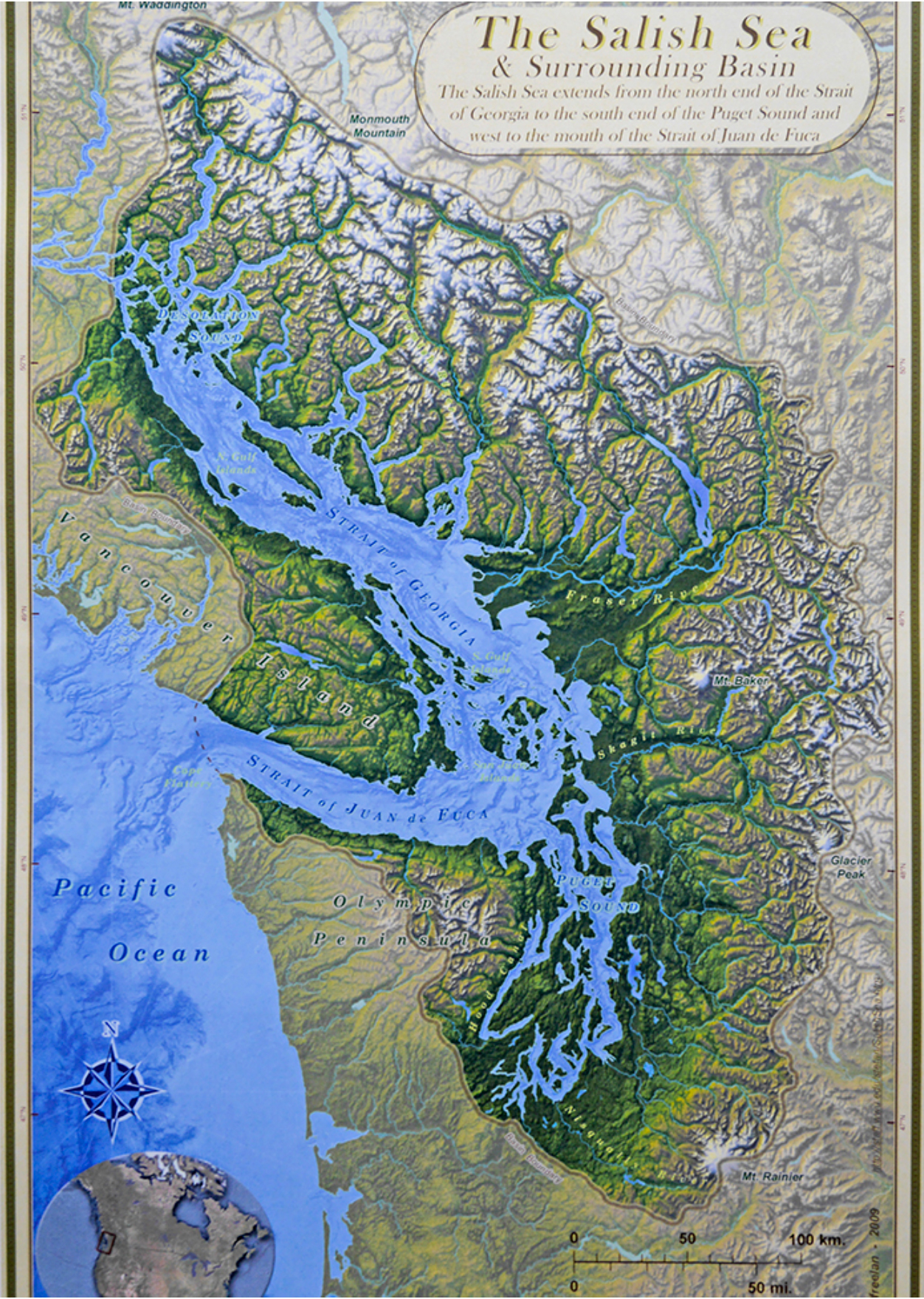 Map of the Salish Sea and surrounding basin by Stefan Freland, University of Western Washington
Map of the Salish Sea and surrounding basin by Stefan Freland, University of Western Washington
THE FIRST BOMB: The Athabasca Tar Sands project in Alberta is the single largest source of greenhouse gas emissions in Canada. It is also the single largest engineering, mining and extractive project on the face of the earth. The tar sands are the size of England.
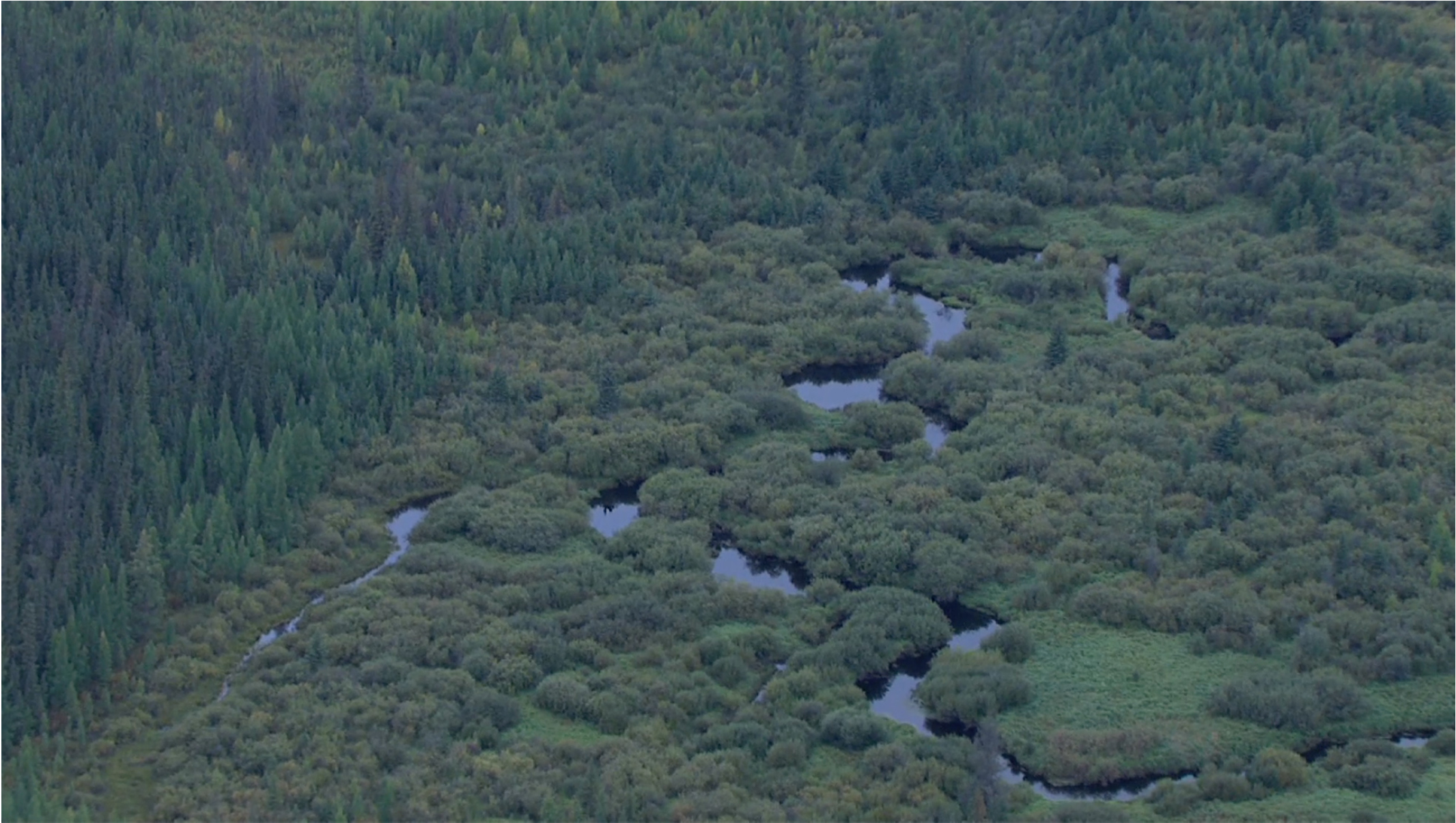 An aerial view of the Athabasca forest in Northern Alberta before tar sands mining and extraction, from the film Petropolis by Peter Mettler Photo Greenpeace
An aerial view of the Athabasca forest in Northern Alberta before tar sands mining and extraction, from the film Petropolis by Peter Mettler Photo Greenpeace
The tar sands fossil fuel extraction process is enormous and extremely dirty. It is poisonous, deadly, and hellish beyond description.
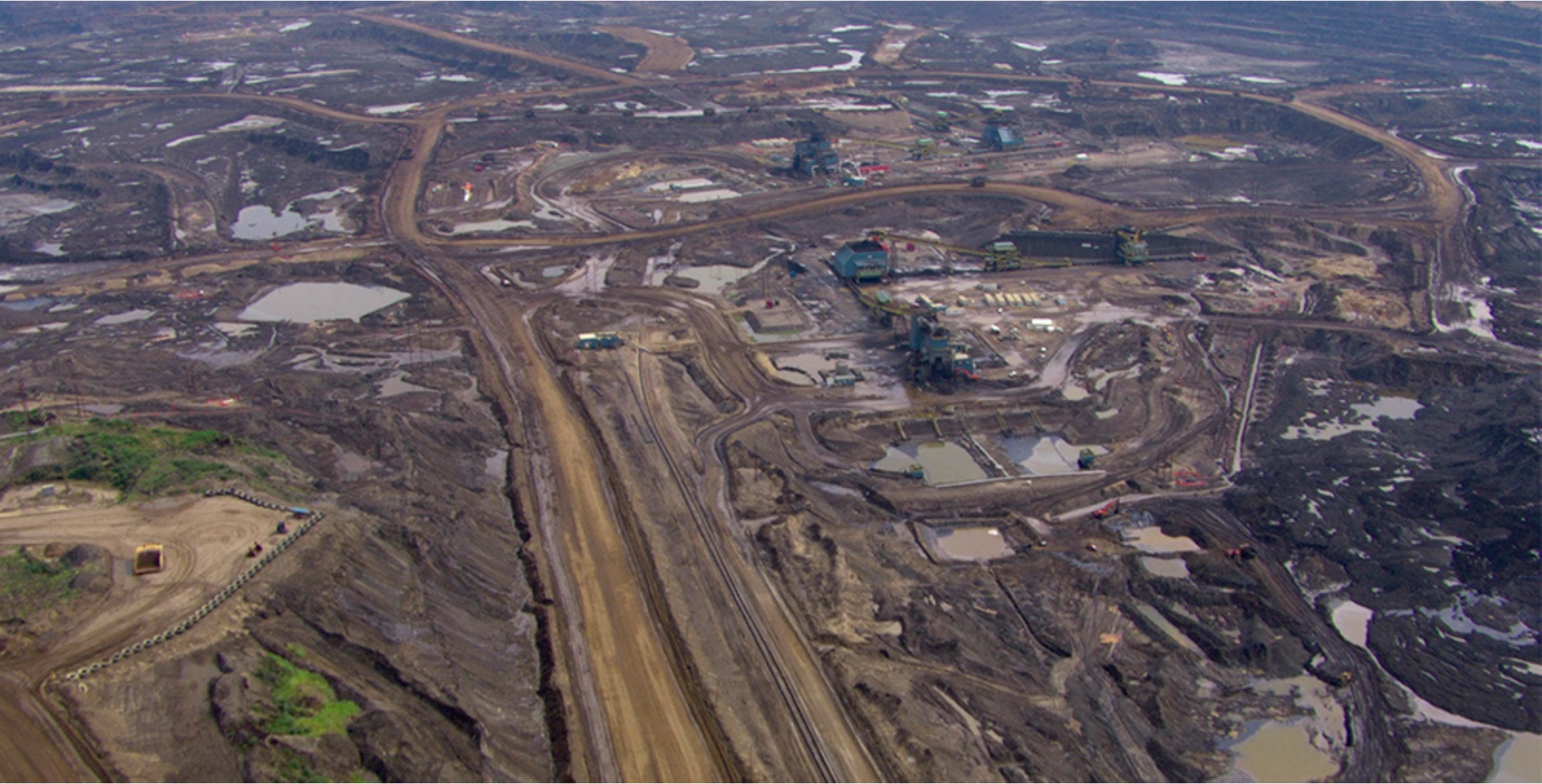 An aerial view of tar sands bitumen extraction, from the film Petropolis by Peter Mettler Photo Greenpeace
An aerial view of tar sands bitumen extraction, from the film Petropolis by Peter Mettler Photo Greenpeace
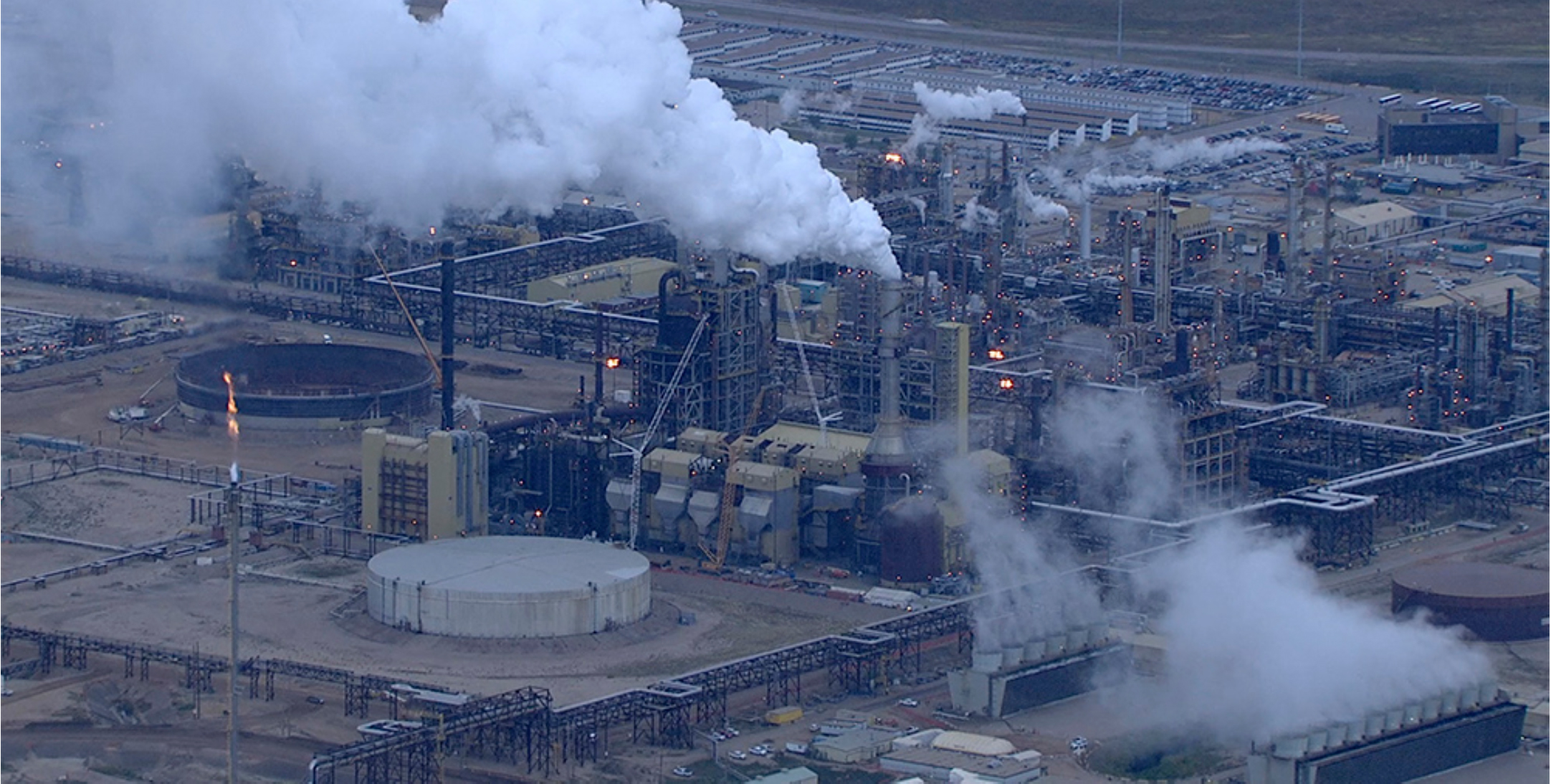 An aerial view of a tar sands processing plant, from the film Petropolis by Peter Mettler Photo Greenpeace
An aerial view of a tar sands processing plant, from the film Petropolis by Peter Mettler Photo Greenpeace
 In this unretouched photo, taken in July 2013, the Syncrude plants are several kilometres away. The tailings waste “pond” in the foreground is as large as a lake. The air is foul, smells of polycyclic aromatic hydrocarbons and reduces visibility. The area sounds like a war zone with continuous cannon fire from floating platforms to keep migratory birds from landing on the toxic lakes.
In this unretouched photo, taken in July 2013, the Syncrude plants are several kilometres away. The tailings waste “pond” in the foreground is as large as a lake. The air is foul, smells of polycyclic aromatic hydrocarbons and reduces visibility. The area sounds like a war zone with continuous cannon fire from floating platforms to keep migratory birds from landing on the toxic lakes.
Just ask the First Nations people of Fort Chipewyan, who live downstream from the mines, processing plants, and tailings waste lakes leaking toxins into the Athabasca River, how hellish the situation is. They are dying of types of cancers which are very rare in the rest of the Canadian population.
The following is an excerpt from the article “Deformed Fish Found Downstream of Tar Sands Mines” by Jason Mark in the June 13, 2012 issue of the Earth Island Journal:
First Nations Communities Worried about their Health
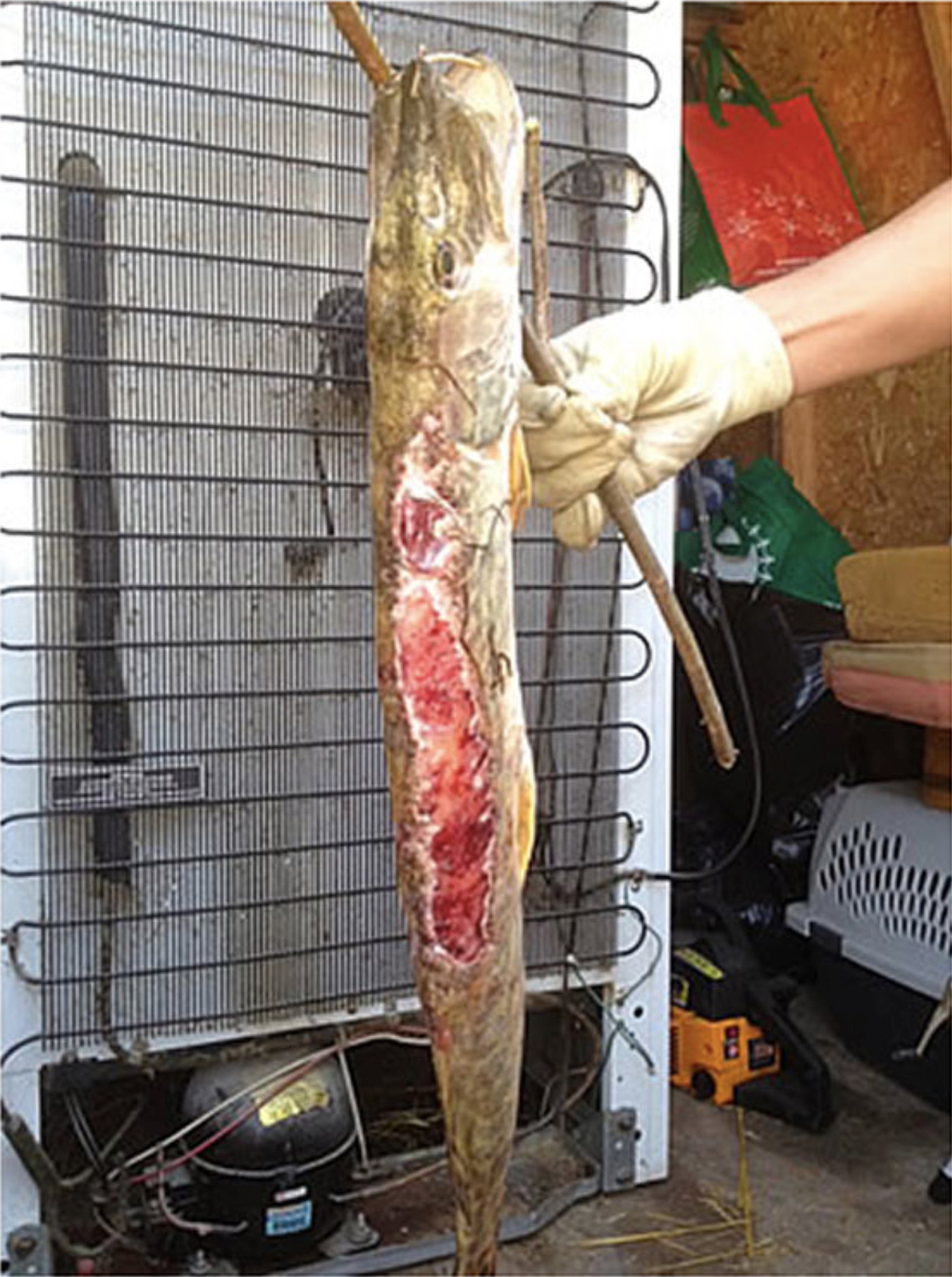 “Chief Allan Adam, the head of the Fort Chipewyan community in the far north of Alberta, has been fishing in Lake Athabasca for all of his life. His father, now 76 years old, has been fishing there even longer. And neither of them has seen what they pulled from the lake on May 30: two grotesquely deformed, lesion-covered fish.
“Chief Allan Adam, the head of the Fort Chipewyan community in the far north of Alberta, has been fishing in Lake Athabasca for all of his life. His father, now 76 years old, has been fishing there even longer. And neither of them has seen what they pulled from the lake on May 30: two grotesquely deformed, lesion-covered fish.
When they caught the sickly fish, each taken from a different part of the lake, the two indigenous men immediately figured it had something to do with the tar sands oil mines that lie about 300 kilometers upstream along the Athabasca River.
“We have been putting two and two together, and raising concerns about the fast pace of (tar sands) development,” Chief Adam told me in a phone interview this week. “The tailing ponds are leaking and leaching into the rivers, and then going downstream to Lake Athabasca.”
Here in the United States, public opposition to the tar sands has centered on the Keystone XL pipeline, how it could jeopardize fresh water supplies of the Ogallala Aquifer and how it would increase greenhouse gas emissions by keeping us locked into the petroleum infrastructure.
For the people of Fort Chipewyan— a community of about 1,200 that is only accessible by plane most of the year— the environmental impacts of the tar sands are already a lived reality.
According to a 2009 study by the Alberta Cancer board, the cancer rate in Ft. Chipewyan is higher than normal. Many of the residents there blame the industrial development south of them for the disproportionate cancer rates.”
∞∞∞
After nearly 16 years of health service at Fort Chipewyan, Dr. John O’Connor was fired in April, 2015 after he had made the news by speaking out about the elevated cancer rate in Northern Alberta communities, believing them to be linked to tar sands activities.
The following is an excerpt from an article by Brandi Morin in the APTN National News on May 11, 2015, about the circumstances of Dr. O’Conner’s firing:
“‘I emailed back and asked them ‘why?’ but didn’t get a response,’ said O’Connor.
In 2007, four years after O’Connor sounded the alarm regarding his concerns of a rare type of cancer he noticed trending among residents in Fort Chip, Health Canada accused him of engendering mistrust, blocking access to files, billing irregularities, and raising undue alarm in the community.
The professional misconduct charges threatened his medical license with the Alberta College of Physicians and Surgeons; however, O’Connor was cleared of all charges minus raising undue alarm.
Then in March 2009, the residents of Fort Chip released a statement in support of O’Connor and demanded that the remaining charge against him be dismissed.
‘This charge of “causing undue alarm,” since it was lodged, was the cause of much frustration and disbelief by residents of Fort Chipewyan,’ the statement said.
“Frustration, because the residents of the community have never been consulted on whether we agree with the charge; and disbelief that the very responsible authority who is charged with protecting our interests and our health was actually lodging the complaints against Dr. John O’Connor, rather than coming to the aid of our community to find resolution to Dr. John O’Connor’s claims.’
The new Kinder Morgan pipeline, if built, will increase tar sands extraction.
The legacy of tar sands extraction and bitumen burning will haunt future generations, long after we are gone.
THE SECOND BOMB: A new three-foot diameter pipeline roughly along the path of the 1,150-kilometer long existing two-foot diameter pipeline from Edmonton to Burrard Inlet in B.C.
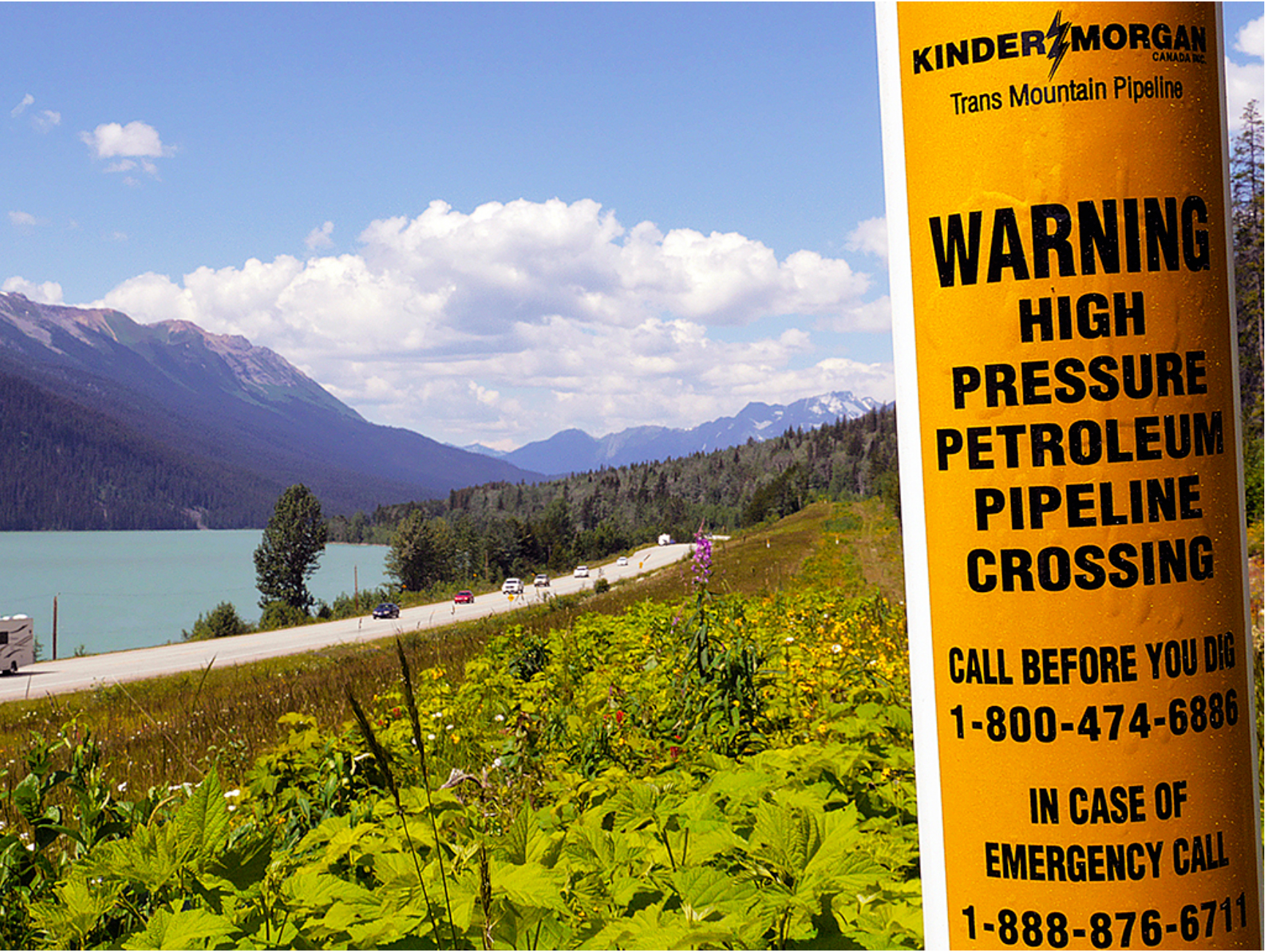 Jasper National Park on the Kinder Morgan pipeline route
Jasper National Park on the Kinder Morgan pipeline route
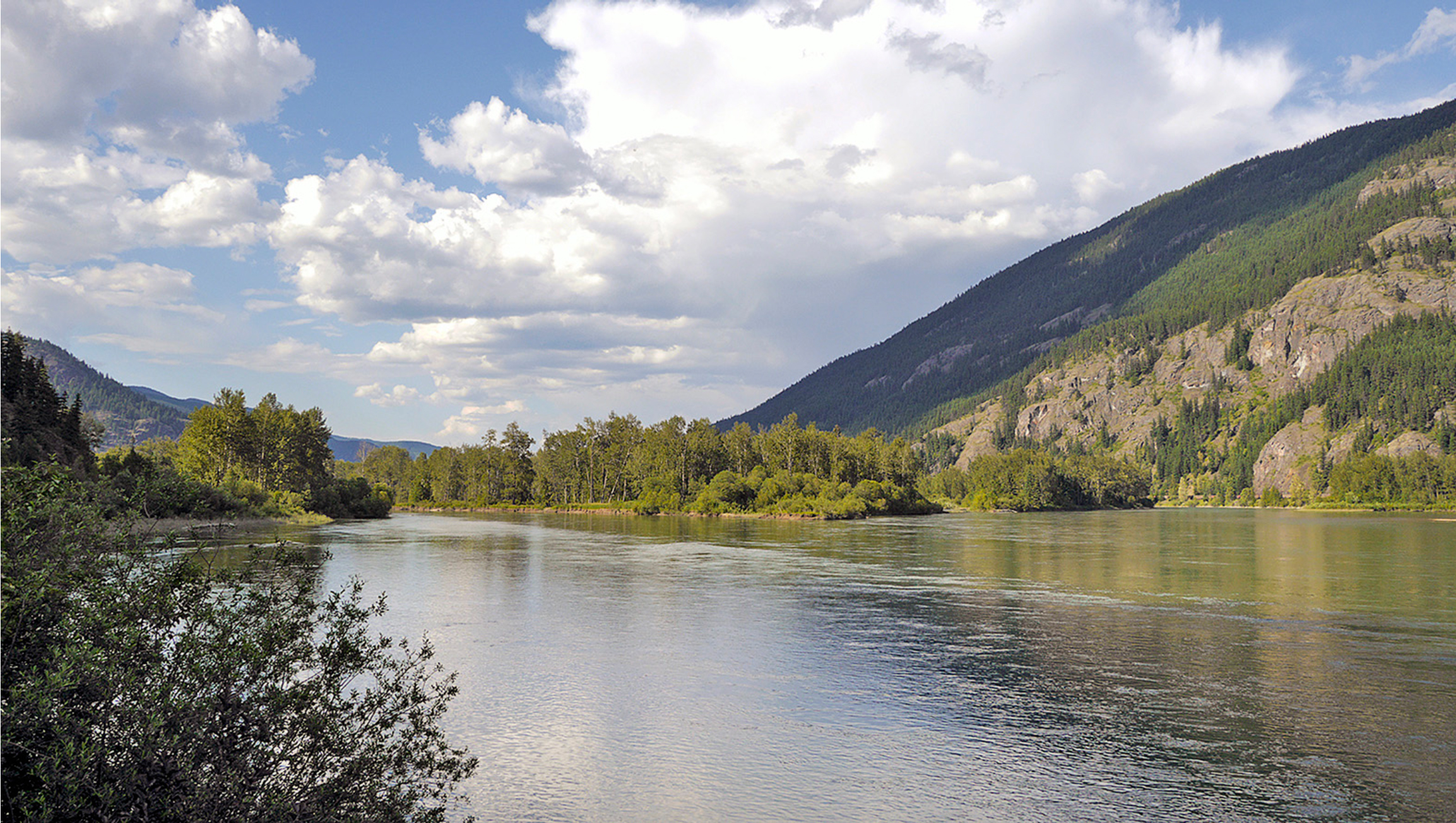 The pipeline route follows the Fraser and North Thompson Rivers
The pipeline route follows the Fraser and North Thompson Rivers
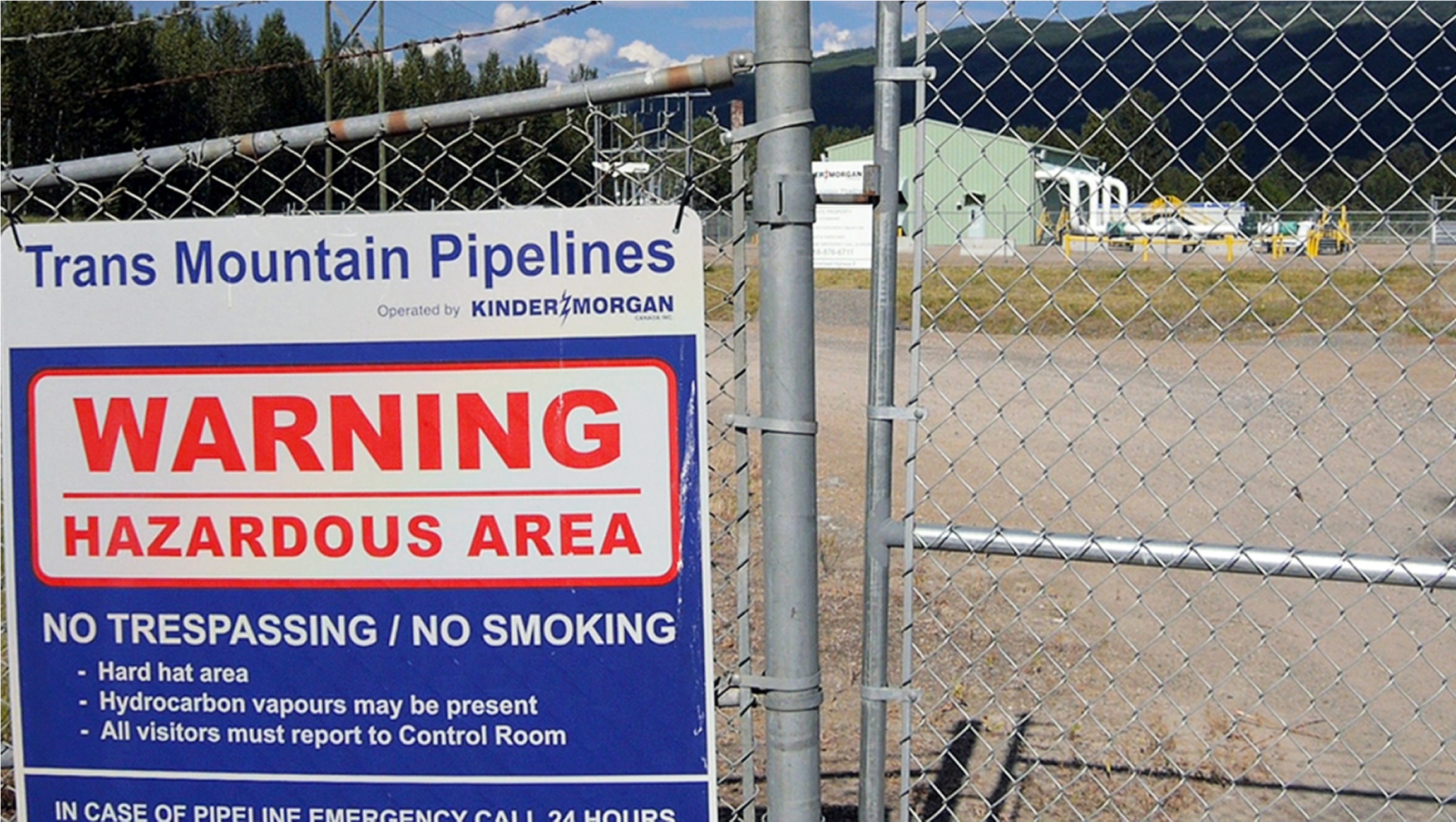 At a number of points the pipeline is just a few meters away from the rivers.
At a number of points the pipeline is just a few meters away from the rivers.
A pipeline rupture would be devastating to the pristine wetlands and habitat along the pipeline route. It could spell the death knell for salmon populations already struggling from the impacts of climate change and open-pen salmon farms.
The Fraser River is one of the most important, if not the most important salmon-bearing river in the world.
THE THIRD BOMB: The expansion plan would increase Kinder Morgan storage capacity on Burnaby Mountain to 5,5 million barrels of volatile, toxic, highly flammable and explosive diluted bitumen. The oil tanks on Burnaby Mountain are actually termed a “tank farm”. Unconscious irony?
Burnaby Mountain is a densely populated urban area in close proximity to schools, homes and Simon Fraser University, a major university campus.
 An aerial view of the present Kinder Morgan oil storage tanks, at centre, on Burnaby Mountain
An aerial view of the present Kinder Morgan oil storage tanks, at centre, on Burnaby Mountain
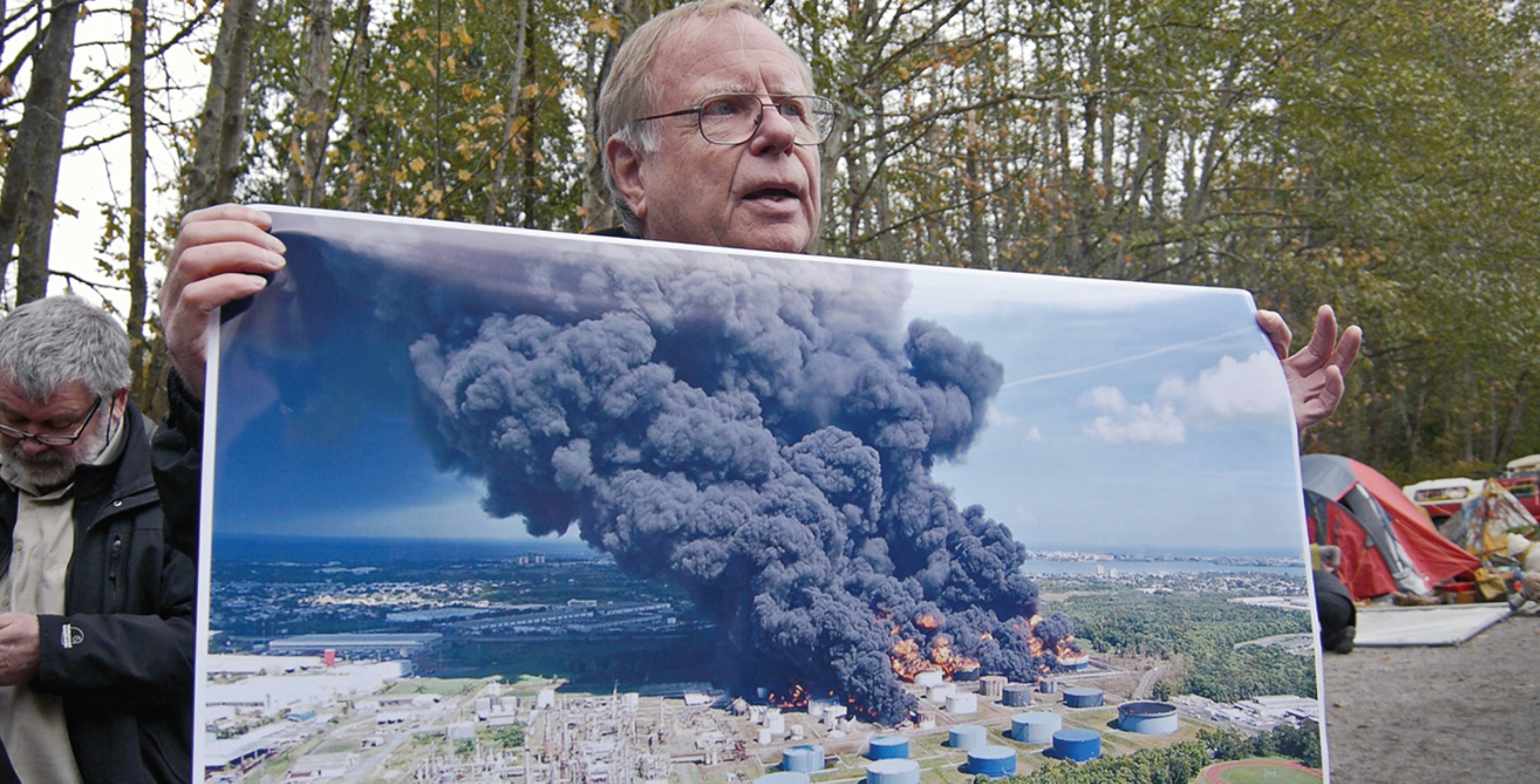 John Clarke, a Burnaby resident, holds a photo of a burning oil storage
John Clarke, a Burnaby resident, holds a photo of a burning oil storage
On July 24, 2007, a contractor ruptured the Kinder Morgan high pressure oil pipeline between Burnaby Mountain and the marine terminal. Eleven homes were covered in oil, 250 residents were evacuated, and 250,000 litres of oil were spilled into Burnaby Inlet (210,000 litres were recovered). The clean-up cost between 15 and 17 million dollars.
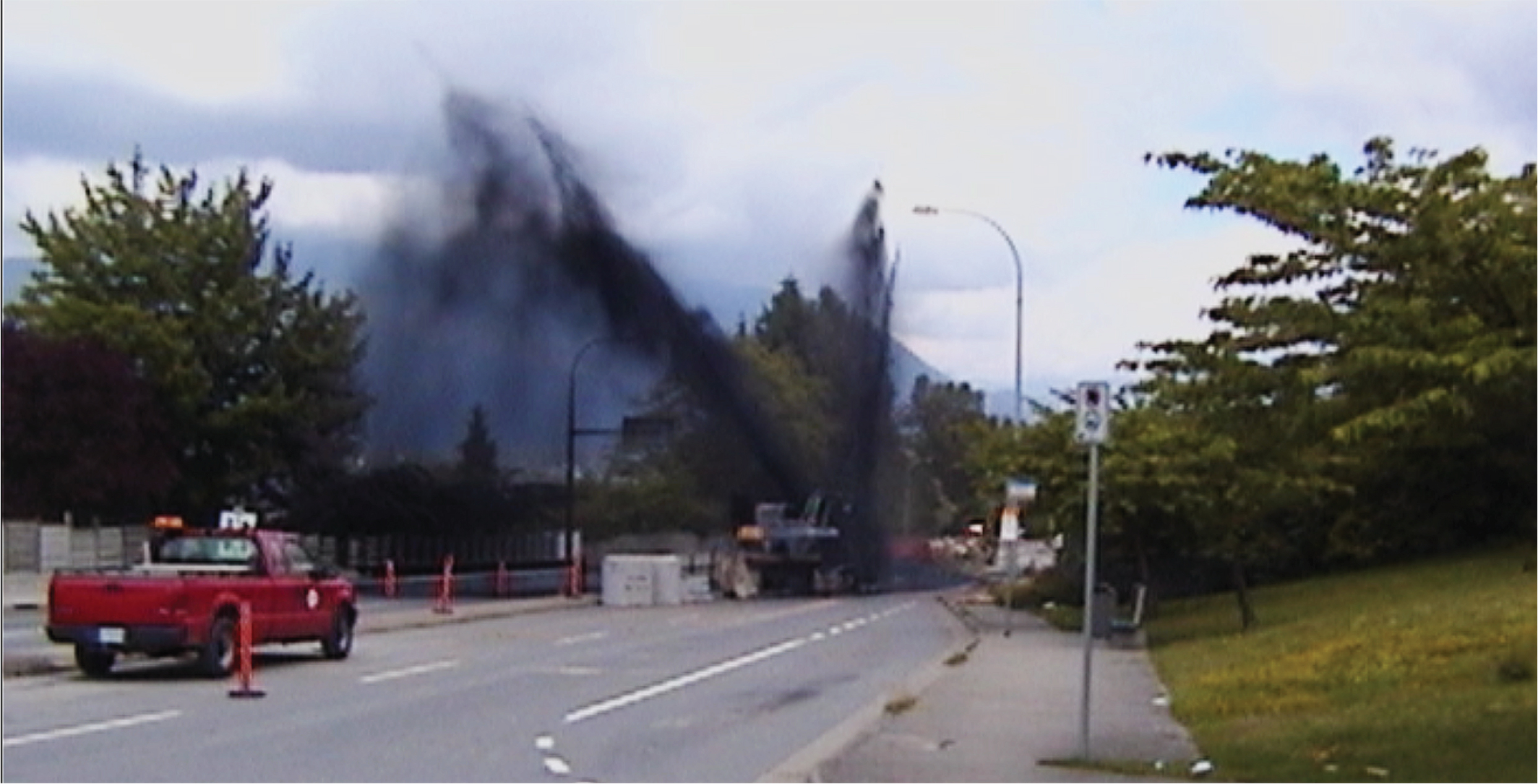 Photo Shawn Soucy
Photo Shawn Soucy
The Transportation Safety Board of Canada report of the incident stated: “Inadequate communication within Kinder Morgan Canada Inc. (KMC) and between KMC, the consultant, and the contractor resulted in no common understanding or acceptance of the project work plan and the contractor’s construction schedule.”
THE FOURTH BOMB: Kinder Morgan will expand the terminal at Burrard Inlet to allow three huge tankers to dock at once. Presently, only one tanker can dock. The increase in tanker traffic carries enormous risk.
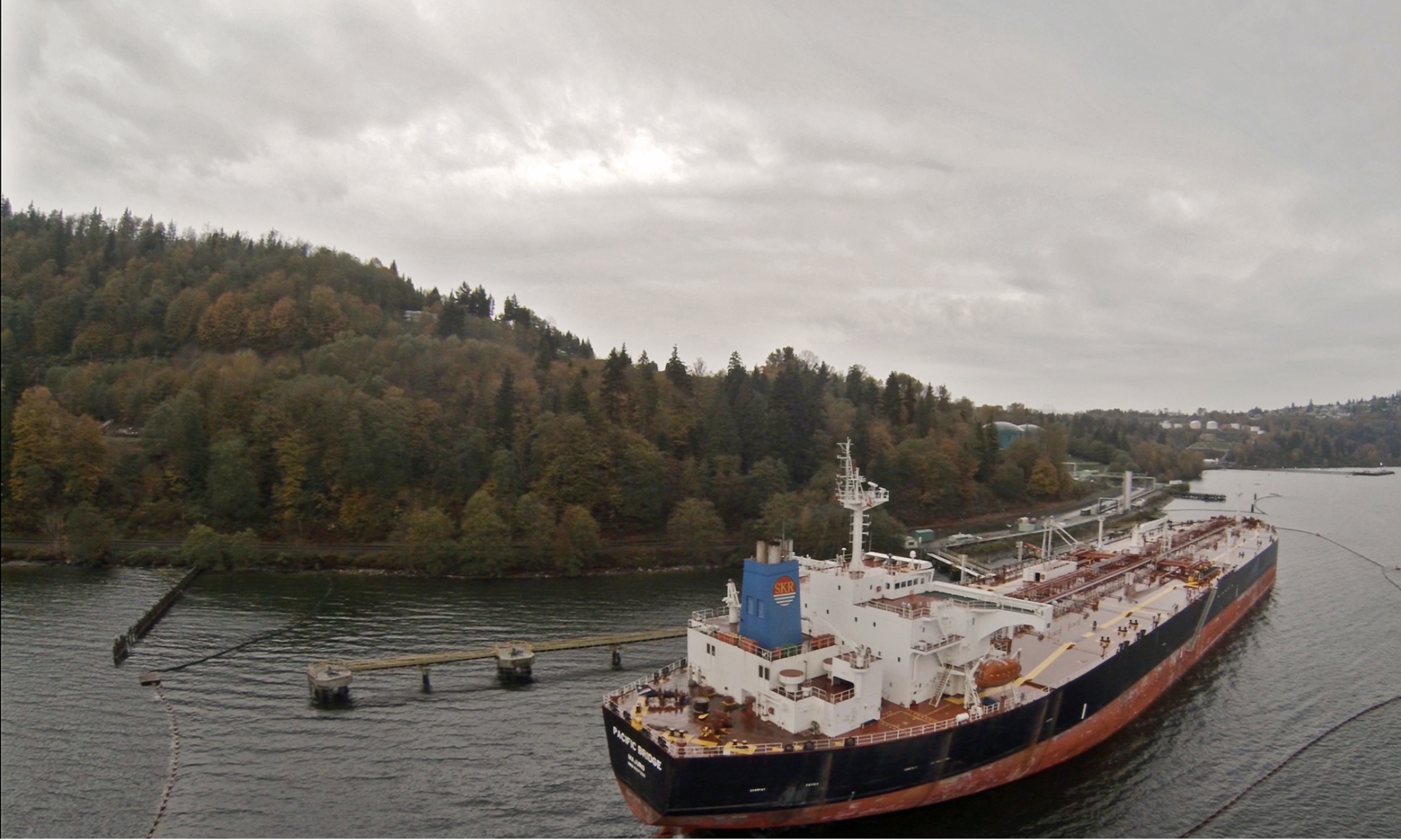 The crude oil tanker Pacific Bridge (Ocean Lady until January 2012) loading from the Kinder Morgan Westridge terminal at Burrard Inlet
The crude oil tanker Pacific Bridge (Ocean Lady until January 2012) loading from the Kinder Morgan Westridge terminal at Burrard Inlet
The Pacific Bridge is an Aframax-class (up to 120,000 tonnes) tanker. It has 105,579 DWT (deadweight tonnes, the total weight of the ship including the cargo), has a length of 239 metres, and is registered in the Marshall Islands. The vessel uses the Marshall Islands as a flag of convenience. Each ship is registered as its own corporate entity. The two liability funds are less than $1.6 billion Cdn and $1.15 billion US. Kinder Morgan’s liability ends at the end of their pipe at the terminal. The public carries the real liability.
Currently Kinder Morgan’s single pipeline can pump 300,000 barrels per day. The expansion plan will increase this capacity to 890,000 barrels per day.
At this time, four or five Aframax-class tankers per month pass through the Salish Sea. With the expansion this would theoretically increase to 34 tankers per month. Per year the total would go from 48 or 60 to no less than 408.
But the new pipeline actually has a hidden capacity. With the addition of more powerful pumps the two pipelines have a combined capacity of 1.1 million barrels per day.
This means that 475 Aframax-size tankers per year will pass through the Salish Sea. That is more than nine per week.
Here is some perspective from past records of Port Metro Vancouver. Metric tonnes of crude oil exported via Kinder Morgan’s Westridge terminal:
2000: 8,404
2001: 512,886
2002: 805,596
2003: 1,118,154
2004: 452,003
In 2005, Kinder Morgan bought the Trans Mountain pipeline. Exports increased:
2005: 1,166,538
2006: 1,311,648
2007: 2,138,101
2008: 2,208,847
2009: 3,916,333
But Kinder Morgan’s aggressive expansion did not just increase volumes. The nature of the product has changed.
The Trans Mountain single pipeline was built in 1953 and for most of the time it carried “conventional” petrochemical products. But lately, it has carried more and more diluted bitumen from the tar sands.
The exact content of the tankers is unknown. Kinder Morgan refuses to divulge any information. The properties of the oil, such as specific gravity, the make-up of diluents such as benzene, xylene, toluene, and other components are deemed a “proprietary secret.” Local governments and even first responders do not have this information.
Each Aframax tanker leaving the terminal is loaded to a maximum of 80 per cent. Due to the hazardous conditions at the Second Narrows it is necessary to reduce the vessel’s draft. Therefore, each tanker can carry “only” about 82,000 metric tonnes.
At 408 tankers per year, this means more than 33 million metric tonnes of diluted bitumen will be shipped through the Salish Sea annually. With the addition of the more powerful pumps, this rises to 39 million metric tonnes annually.
This will mean an increase of 4,600 per cent over the amount shipped out in the year 2000.
The risk is incredible. The possibility of an oil spill in the Haro Strait, for example, is estimated to increase by at least 375 per cent.
But before the tankers can reach the Haro or the Juan de Fuca Straits, they must pass through two significant hazard zones: the Second Narrows and the First Narrows in Burrard Inlet.
The Second Narrows channel is very restricted. As tight as it looks from the surface, under water the passage is even more restricted. Tankers have a pilot on board and are tethered to at least two powerful tugs, one at the stern and one at the bow, with highly trained crews. No passage is allowed after dark for these vessels.
Passage through the Second Narrows is a precise and carefully timed manoeuver. Even a slight deviation from the correct time or course, or a mechanical mishap or human error, could result in a major incident.
The tankers can only pass through partially loaded due to the danger of striking the bottom, and at the highest high tide at slack water.
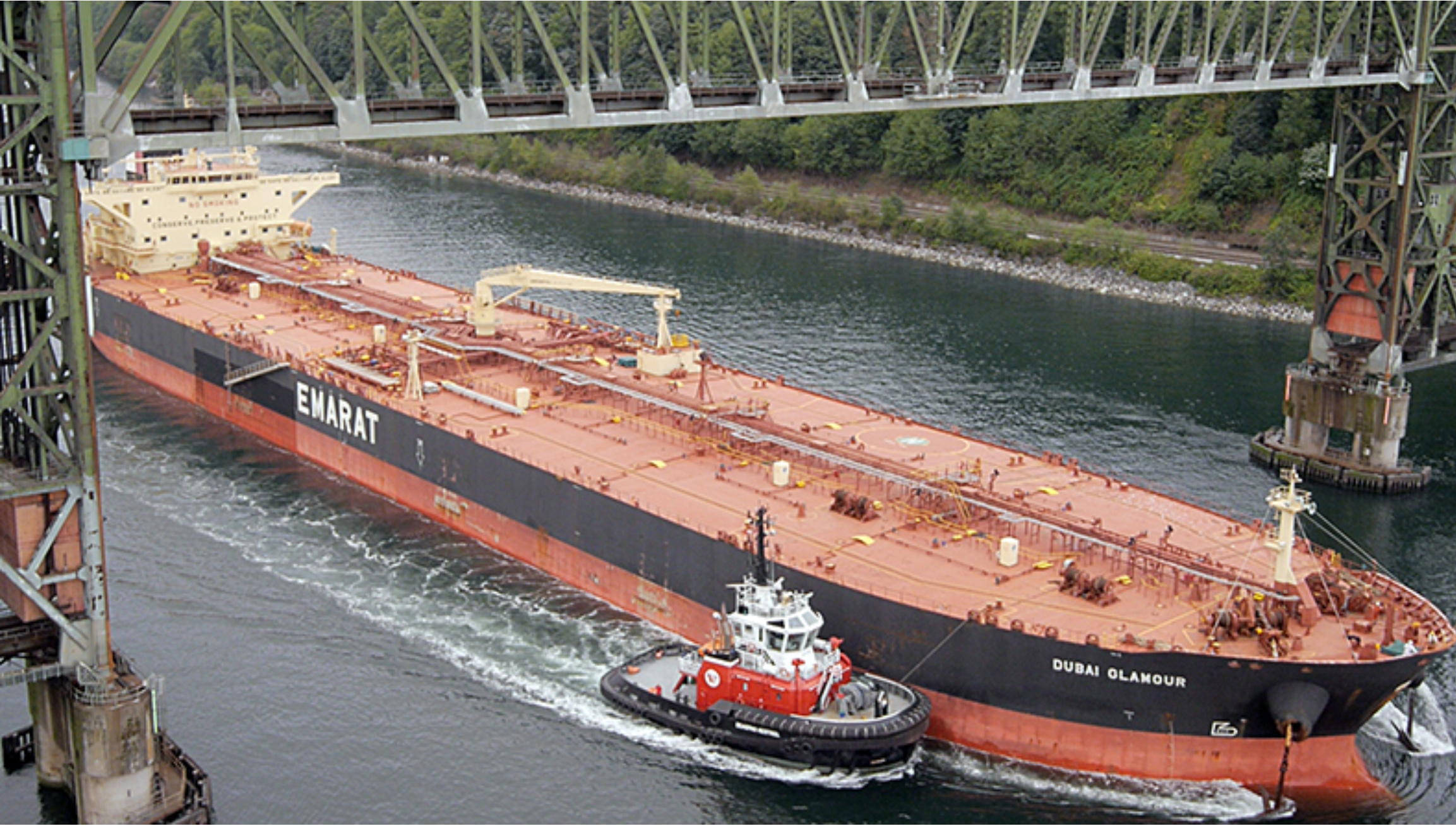 The 115,600-tonne crude oil tanker Dubai Glamour passes through the Second Narrows under the CN rail bridge at the highest high tide after loading at the Kinder Morgan terminal
The 115,600-tonne crude oil tanker Dubai Glamour passes through the Second Narrows under the CN rail bridge at the highest high tide after loading at the Kinder Morgan terminal
Port Metro Vancouver could dredge the channel to allow passage for fully loaded Aframax ships or the much larger Suezmax-class tankers which can carry up to 175,000 tonnes.
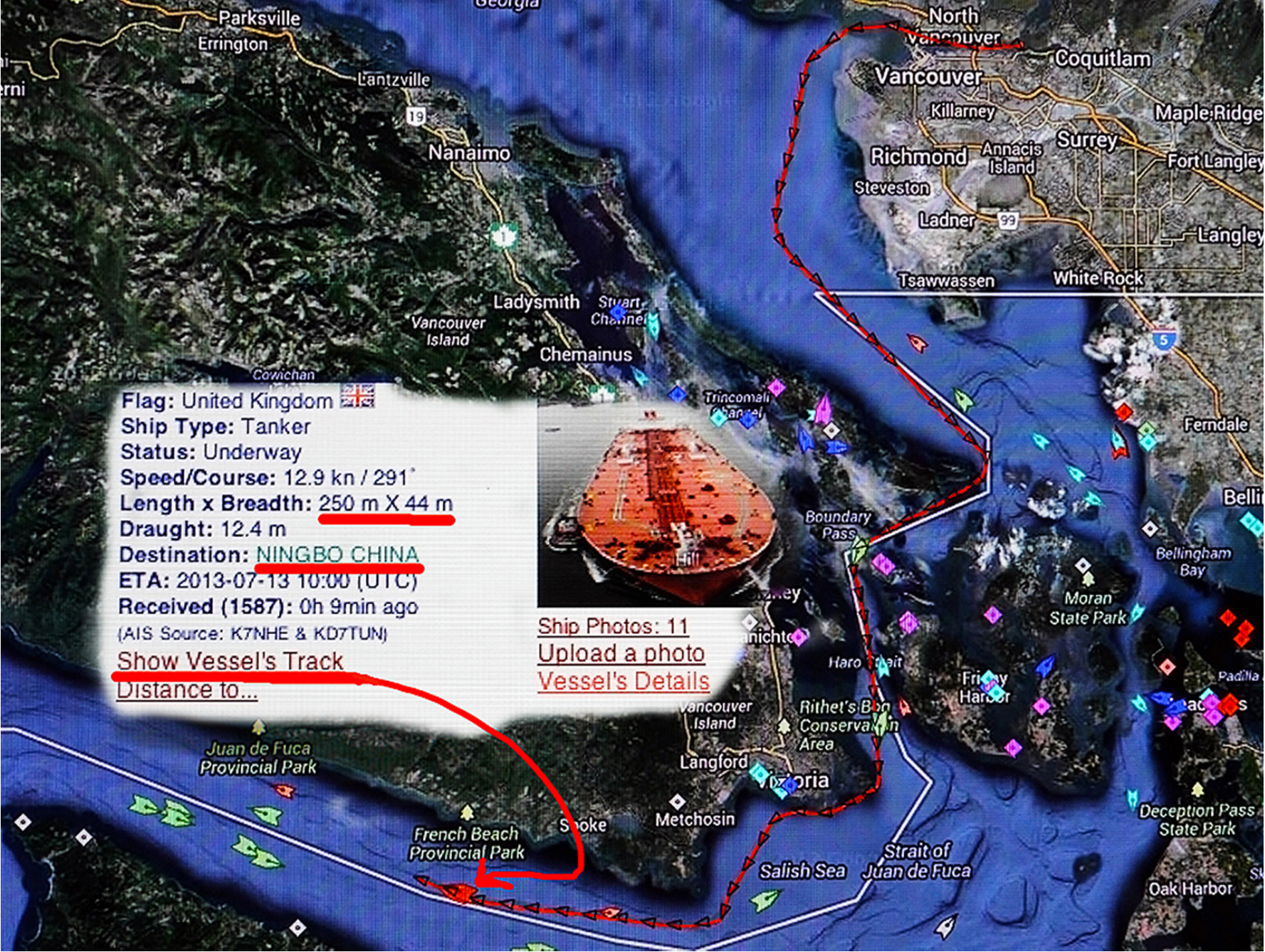 A screen shot from the ship tracking site www.marinetraffic.com showing the vessel track for the crude oil tanker Smart Lady. The vessel is outbound, carrying oil from the Kinder Morgan terminal to Ningbo, China
A screen shot from the ship tracking site www.marinetraffic.com showing the vessel track for the crude oil tanker Smart Lady. The vessel is outbound, carrying oil from the Kinder Morgan terminal to Ningbo, China
On the track from English Bay this vessel came within 2 km of Point Atkinson, 5 km of Cowan Point on Bowen Island, and 18 km of Gospel Rock on the Sunshine Coast.
An incident resulting in a hull rupture and a loss of just 10 per cent of the cargo would mean a spill of 8,000 metric tonnes of diluted bitumen into the waters of the central Strait of Georgia. In the event of a flood tide and a southeasterly wind the above-mentioned points would be “oiled” within a matter of hours.
Continuing on its way the ship came within a few hundred metres of East Point on Saturna Island and then within a couple of kilometres of Victoria where the pilot was dropped off. It then left for the open ocean via the Strait of Juan de Fuca.
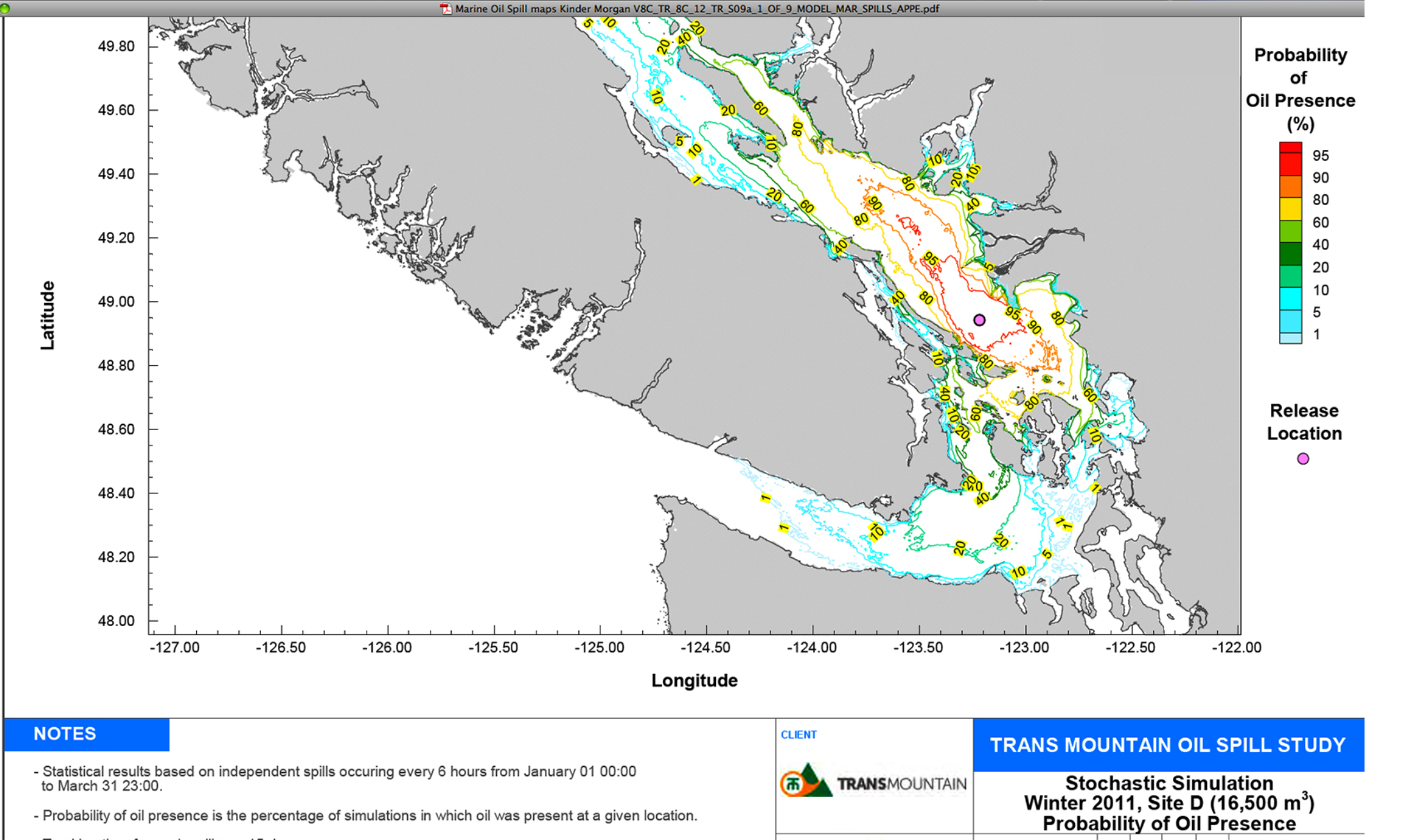
This image shows Kinder Morgan’s own study of a simulated oil spill near the BC Ferries route between Active Pass and Tsawwassen. The probability of oil reaching north of Sechelt is 80 per cent with a 60 per cent risk of oil going as far as the north end of Texada Island.
The chance that oil would reach Bowen Island is 90 per cent; the chance of oiling the Gulf Islands is 95 per cent. Victoria and the US San Juan Islands have a risk of 40 per cent of being oiled.
The Raincoast Conservation Foundation, The Georgia Strait Alliance, and the Friends of the San Juans, did their own study, releasing hundreds of small plywood drift cards. Over time, these are the locations where the cards were reported reaching shore:
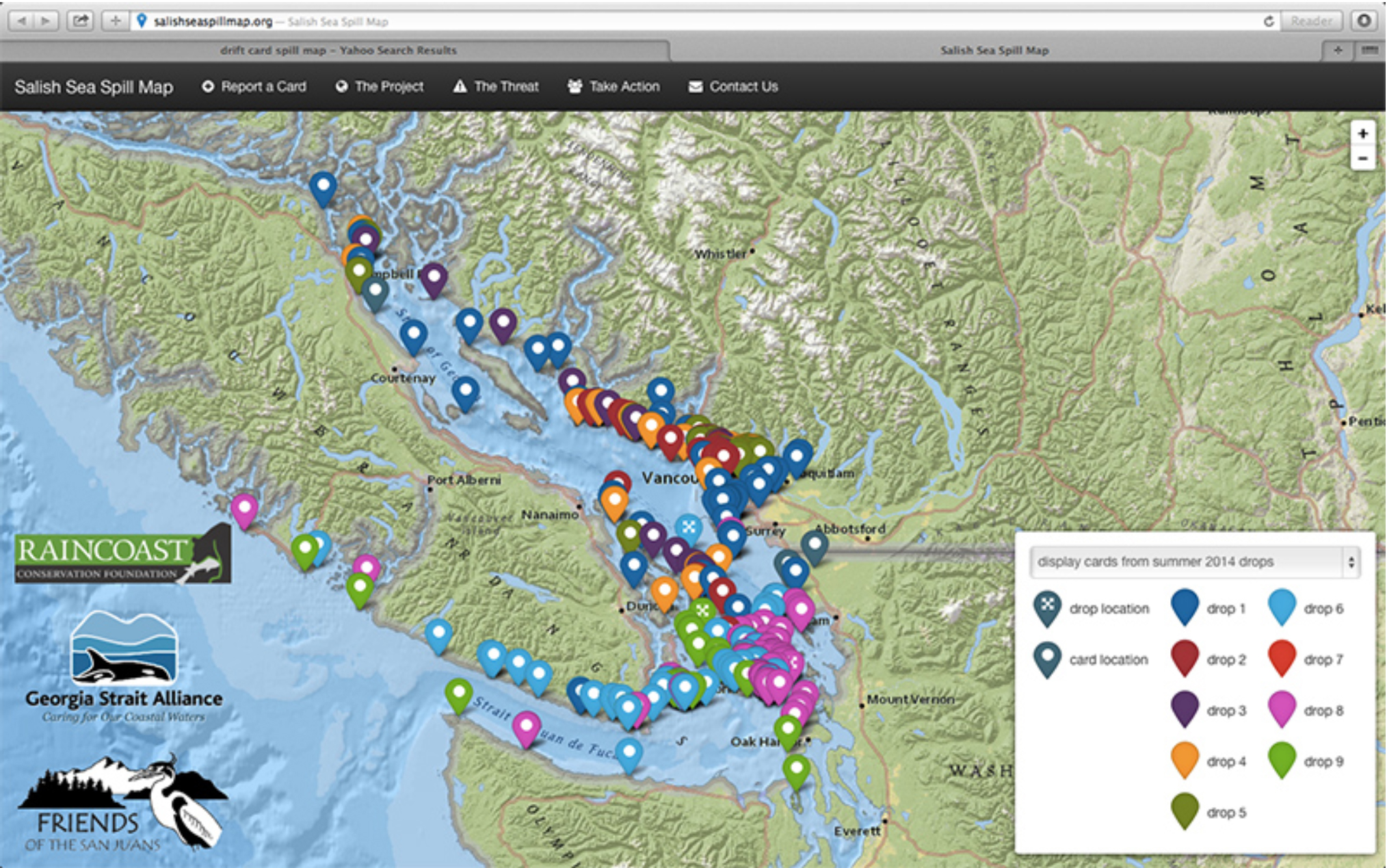
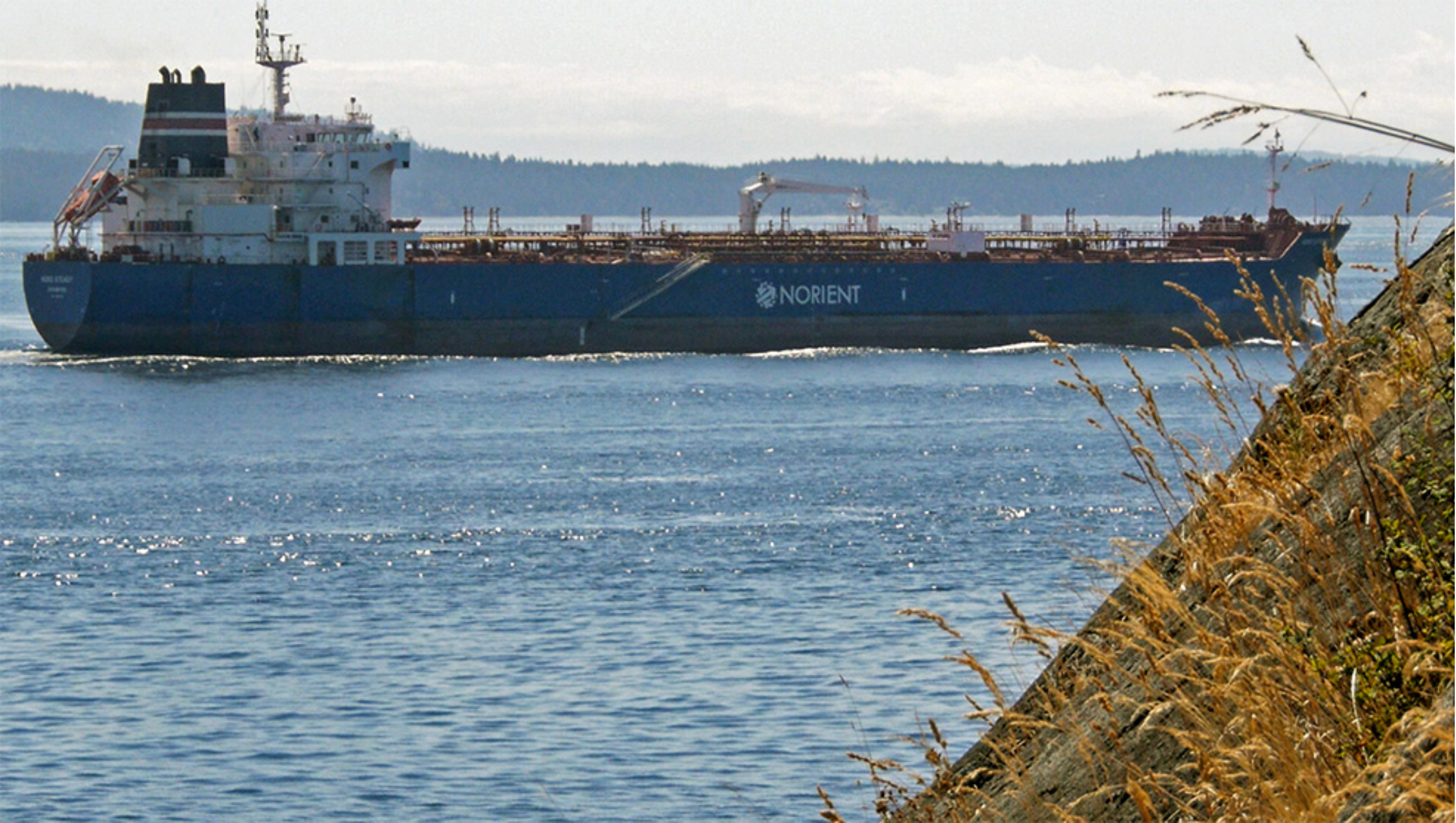 The oil tanker Nord Steady sailing through Boundary Pass, Haro Strait. The ship under Singapore flag can carry 50,000 tonnes and has a length of 183 metres. It is passing within a few hundred metres of East Point on Saturna Island, heading west towards the Haro Strait. The boarding ladder is in the lowered position since they will be dropping off the pilot as they swing in within a couple of kilometres of Victoria.
The oil tanker Nord Steady sailing through Boundary Pass, Haro Strait. The ship under Singapore flag can carry 50,000 tonnes and has a length of 183 metres. It is passing within a few hundred metres of East Point on Saturna Island, heading west towards the Haro Strait. The boarding ladder is in the lowered position since they will be dropping off the pilot as they swing in within a couple of kilometres of Victoria.
Water is generally considered polluted with oil once it contains about 10 mg/l of oil (ten litres of oil per one million litres of water). Therefore, one litre of oil pollutes 100,000 litres of water. One metric tonne of crude oil equals about 1,106 litres. Eight thousand metric tonnes equals 8,848,000 litres which can contaminate 8.8 trillion litres of water if dispersed evenly.
But a spill never disperses evenly. In the case of diluted bitumen the evaporation of diluents would occur rapidly, resulting in enormous clouds of toxic and flammable gas. Large oil slicks would form which would drift on the surface, driven by wind and currents, injuring and killing birds, fish, mammals and planktonic life.
The slicks would eventually oil whatever shoreline they came into contact with, injuring and killing all life. The heavy oil would adhere to the rocky shorelines and the weeds, algae, and grasses. It would sink into the substrata of beaches in poisonous layers. It would destroy prime habitat for herring, sand lance and other forage fish which are foundational species upon which the entire marine food web depends.
However, most of the oil would sink to the ocean floor where it would be impossible to “clean up.” Thousands of tonnes of mats and globs of toxic sludge would cover the bottom in perpetuity, covering rare and delicate glass sponge reefs as well as the sediments where countless invertebrates, molluscs, crabs, prawns and other species make their home.
Dr. Andrew Weaver is a noted scientist, a Nobel laureate, a B.C. MLA and the Green Party leader. In his submission to the National Energy Board hearings on Kinder Morgan’s expansion project, he called for an immediate halt of all tanker shipments of diluted bitumen leaving the Kinder Morgan terminal.
One of his chief concerns was what happens when diluted bitumen comes into contact with sediment particulates in water. Dr. Weaver cited two recent scientific papers:
-The National Academies of Sciences: Spills of Diluted Bitumen From Pipelines: A Comparative Study of Environmental Fate, Effects, and Response
-The Royal Society of Canada Expert Panel: The Behaviour and Environmental Impacts of Crude Oil Released into Aqueous Environments.
The papers discuss how diluted bitumen has a tendency to adhere to sediment particles, creating tar balls that sink after the lighter diluents evaporate.
Why does this tendency have disastrous consequences for the Salish Sea?
 A NASA photo of the Fraser River brackish waters and sediment plume flowing out and over the surface of the heavier, saltier sea water of the Georgia Strait in the Salish Sea
A NASA photo of the Fraser River brackish waters and sediment plume flowing out and over the surface of the heavier, saltier sea water of the Georgia Strait in the Salish Sea
During the freshet, the plume can cover an area of up to 1,500 square kilometers. The surface waters of the Salish Sea are considerably more brackish and lighter than sea water on the outer coast.
This condition drives a process called “estuarine circulation” where the Strait of Juan de Fuca is like an estuary for the Salish Sea. Colder, denser, saltier water finds its way along the bottom into the Salish Sea while warmer, lighter and more brackish water at the surface flows seaward, creating a vital mix and exchange.
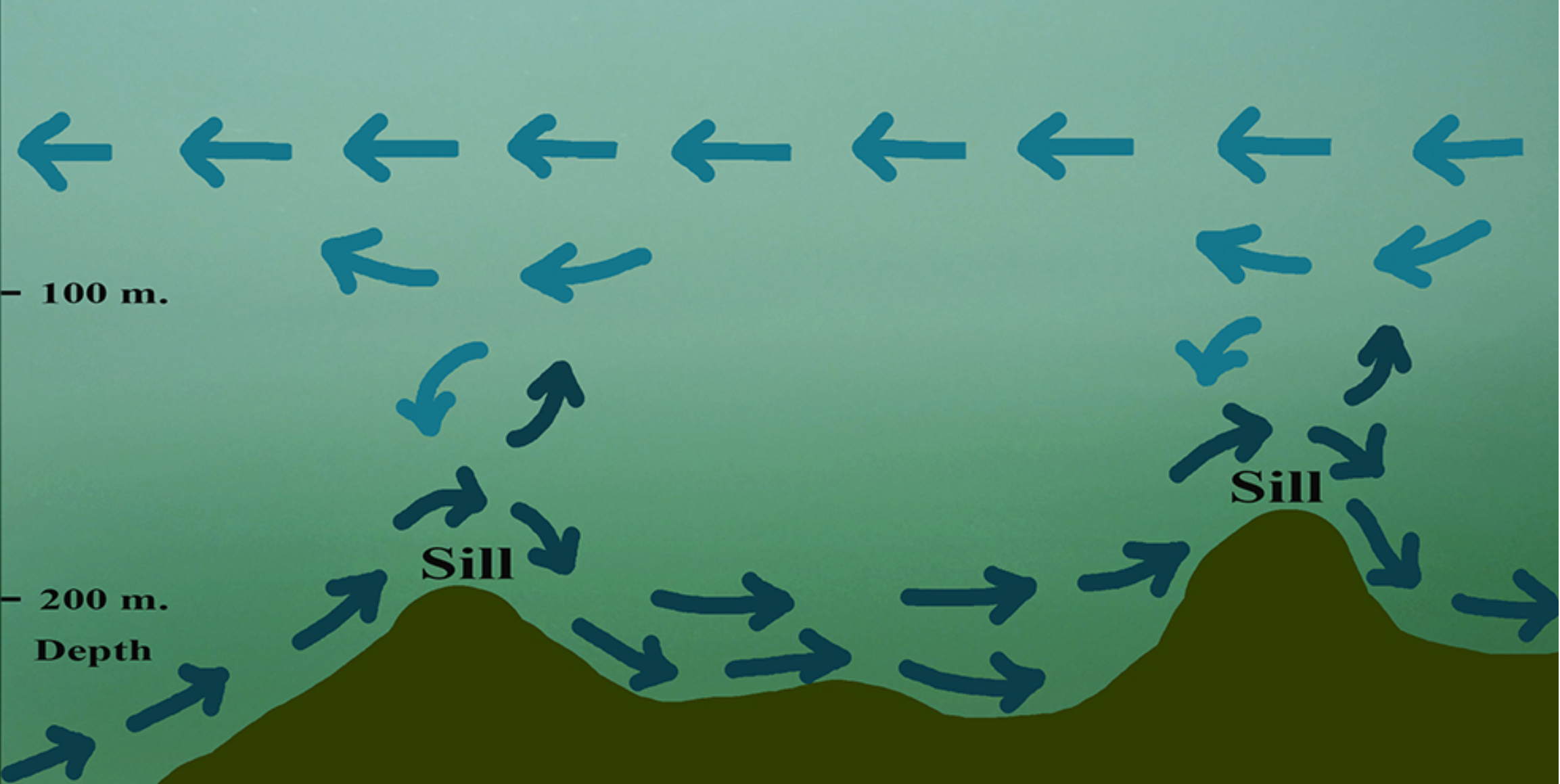 A simplified view of estuarine circulation driven by wind waves, river flows, gravity, tidal currents, upwelling on the outer coast, and the coriolis effect. The light blue arrows are brackish surface waters flowing out to sea, to the left. The dark blue arrows are cold, saltier and denser waters flowing into Salish Sea basin, to the right.
A simplified view of estuarine circulation driven by wind waves, river flows, gravity, tidal currents, upwelling on the outer coast, and the coriolis effect. The light blue arrows are brackish surface waters flowing out to sea, to the left. The dark blue arrows are cold, saltier and denser waters flowing into Salish Sea basin, to the right.
These complex and powerful dynamics draw in vital nutrients, mix oxygen and de-stratify water layers. They have made the Salish Sea one of the most productive habitats on the entire planet.
But in a case of tragic irony, in the event of a diluted bitumen oil spill, these same processes that give life and abundance will also ensure a devastating event to the bio-diversity of ecosystems in the Salish Sea basin.
The dynamics at play are strikingly similar to the blood in our bodies. While it carries vital elements and life-giving oxygen, it can also deliver toxins in a crisis incident or illness. The key difference is that while our blood can dispose of wastes, bitumen has nowhere to go but down; it remains as a heavy oil sludge on the sea floor.
Over a great many decades, sediments will fall and eventually cover the toxic sludge. Meanwhile, we may see a severe degradation of this productive habitat and a collapse of salmon runs, herring populations and a myriad of other species.
What Dr. Weaver addressed was that the Kinder Morgan spill models did not take into account the real conditions within the Salish Sea; the waters in this basin are not a static water column. But Kinder Morgan vehemently denied this and the National Energy Board hearings did not accept or consider the new evidence presented in the two scientific studies mentioned above.
THE FIFTH BOMB: The elevation of corporate control and the “petro-state” which degrade civil society and democracy.
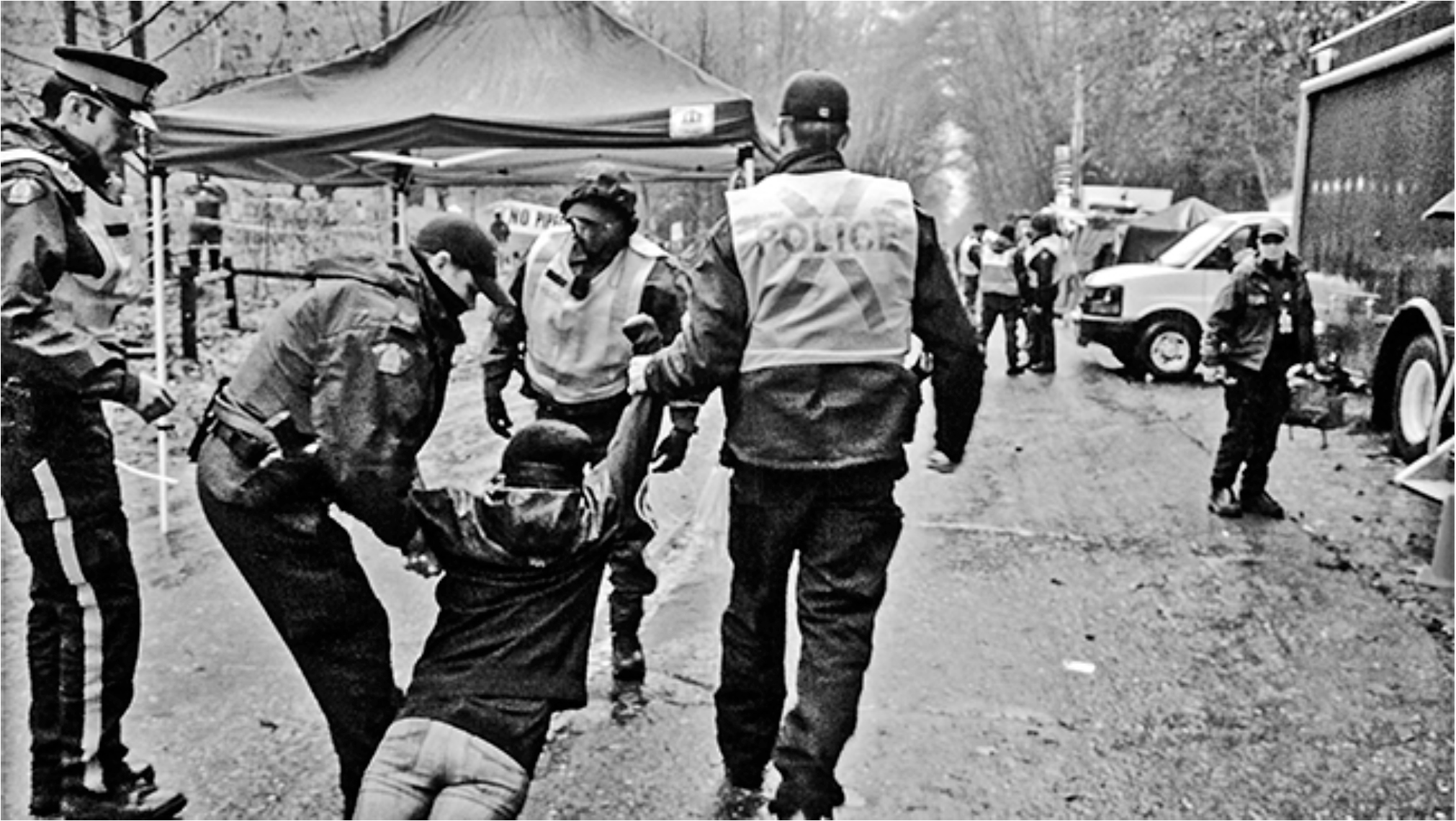 One hundred citizens who protested Kinder Morgan test drilling on Burnaby Mountain in the fall of 2014 were arrested.
One hundred citizens who protested Kinder Morgan test drilling on Burnaby Mountain in the fall of 2014 were arrested.
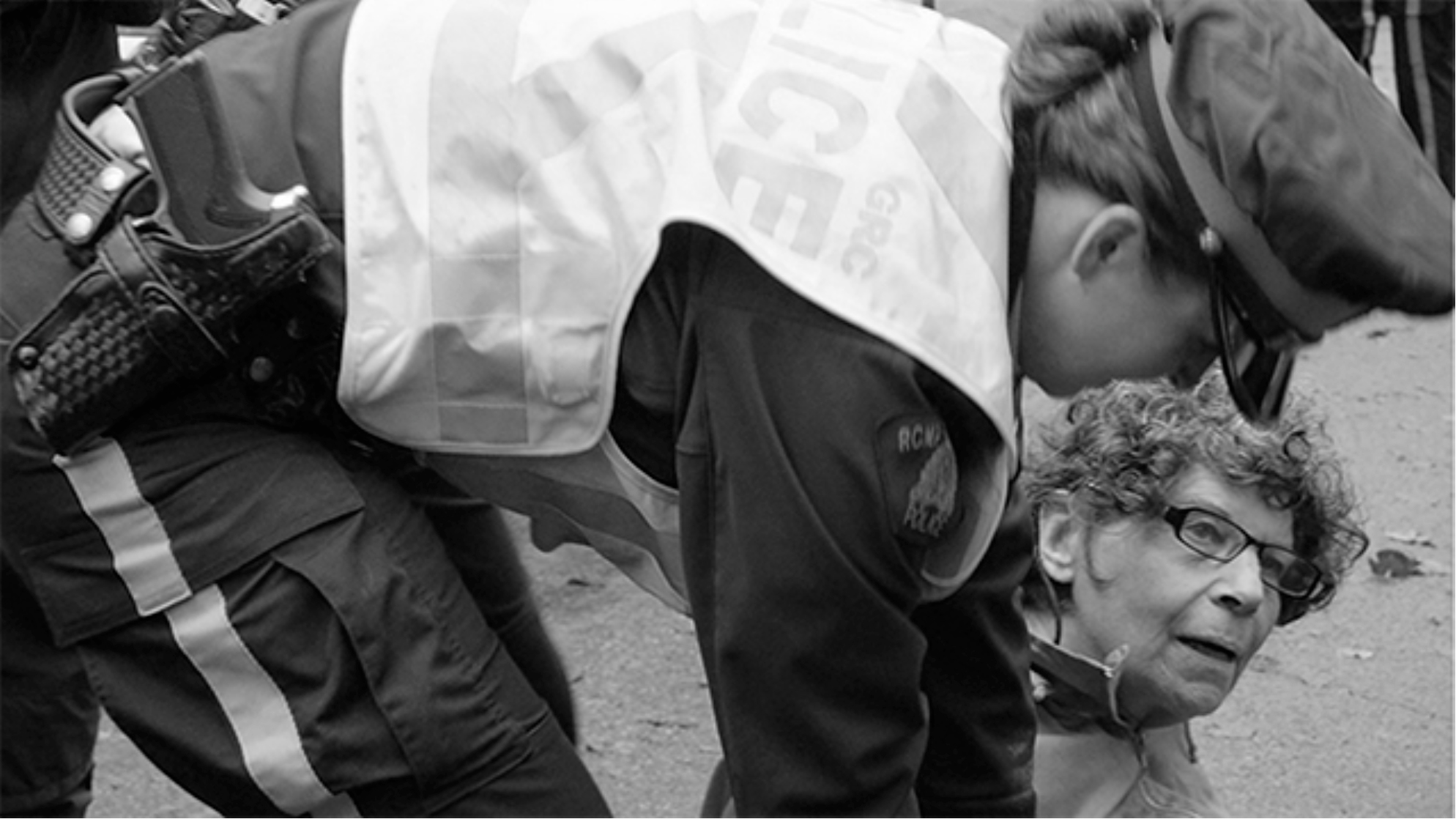
In the fall of 2011, the Canadian Energy Pipeline Association met with senior government officials to ask for changes in legislation. In 2012, under Conservative Prime Minister Stephen Harper, Bill C-45 came into effect. The number of protected lakes and waterways went from 2.5 million to only 159.
Harper’s government also “streamlined” the National Energy Board and stacked it with fossil fuel industry insiders.
Here is an example of the new, more “efficient” NEB hearing procedures. In cross-examination, Kinder Morgan’s lawyers were allowed to question the importance of salmon in the diet of First Nation intervenors. However, no one was allowed to cross-examine Kinder Morgan.
While Elizabeth May and other intervenors were presenting their summations to the NEB in a very large but almost entirely empty ballroom in Burnaby, the public was not allowed to attend.
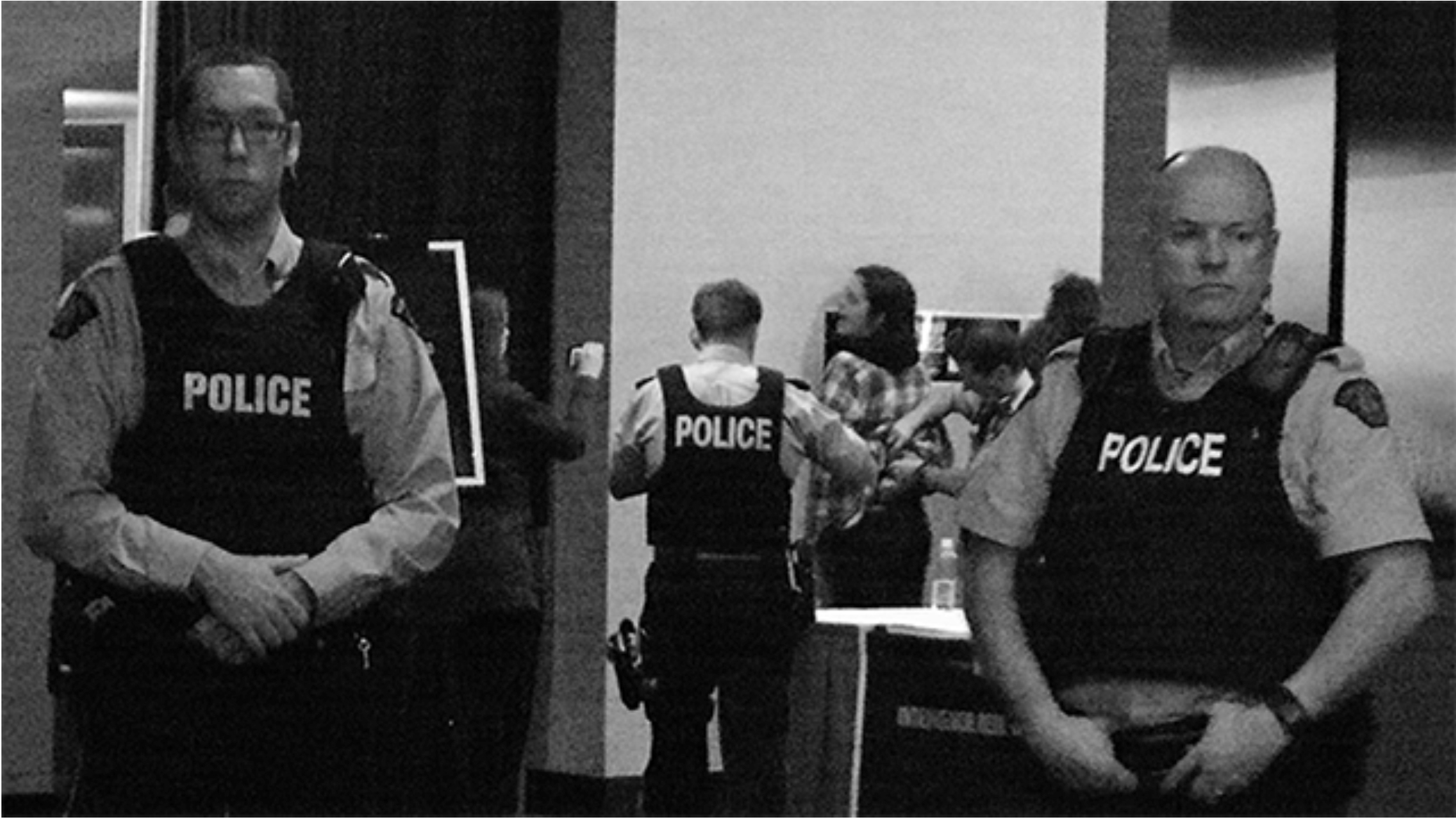 Three peaceful young women who tried to attend the NEB hearing room in Burnaby, Jan. 23, 2016, with the intent of listening to the summations, were immediately arrested by the RCMP
Three peaceful young women who tried to attend the NEB hearing room in Burnaby, Jan. 23, 2016, with the intent of listening to the summations, were immediately arrested by the RCMP
The NEB hearing process was tainted. It was an affront to truth and justice, to First Nations, and to civilized conduct and democracy.
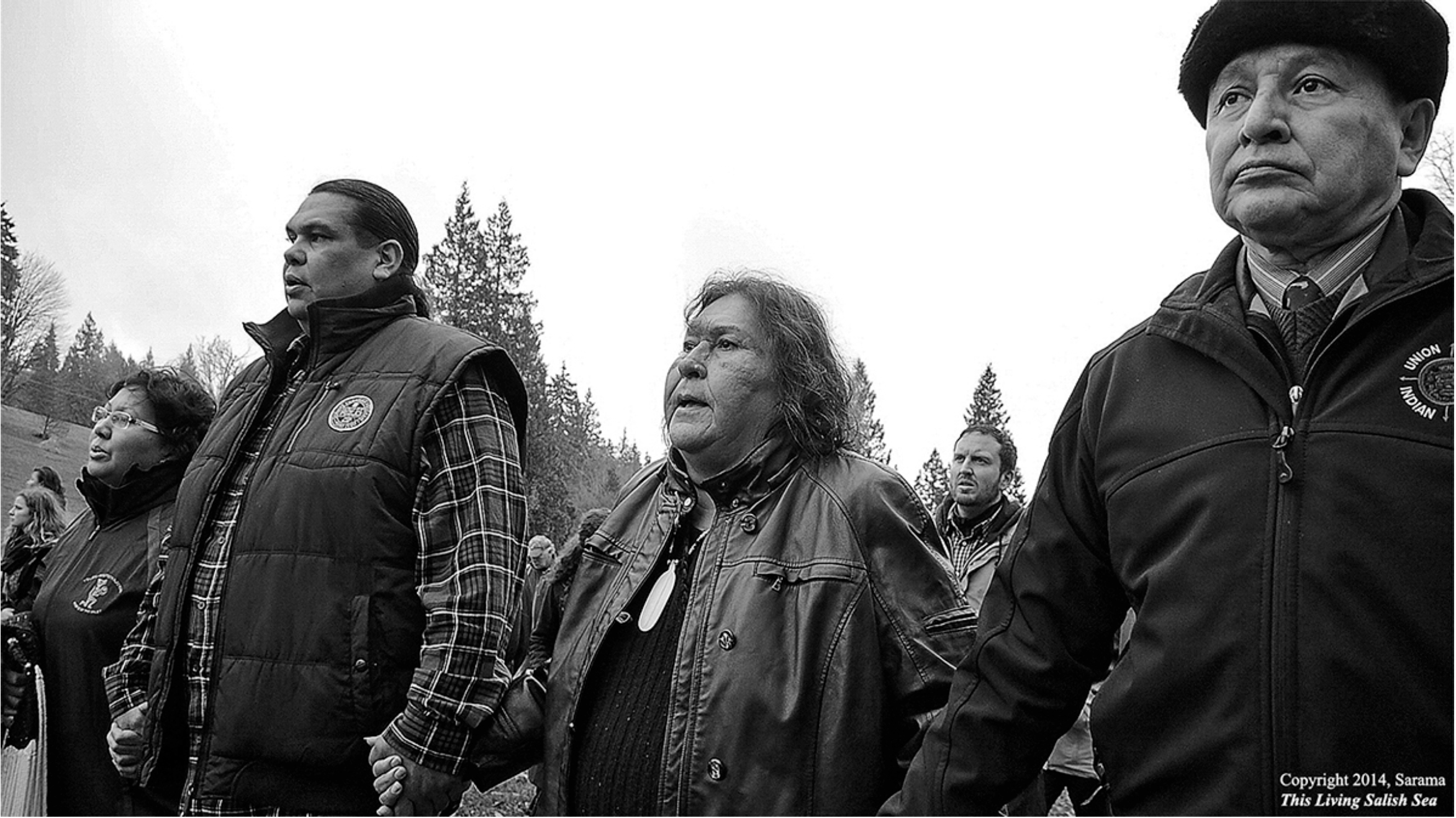 Tsleil-Waututh members Charlene Aleck, Reuben George, Amy George (granddaughter, grandson and daughter, respectively, of Chief Dan George), and Grand Chief Stewart Phillip stand in resistance to Kinder Morgan on Burnaby Mountain in 2014, unceded Coast Salish territory.
Tsleil-Waututh members Charlene Aleck, Reuben George, Amy George (granddaughter, grandson and daughter, respectively, of Chief Dan George), and Grand Chief Stewart Phillip stand in resistance to Kinder Morgan on Burnaby Mountain in 2014, unceded Coast Salish territory.
First Nations across B.C. and Washington state have signed a treaty to protect the Salish Sea. The Tsleil-Waututh First Nation lives on Burrard Inlet, their ancestral home for thousands of years, directly across from the Kinder Morgan terminal. They say they were not consulted and do not give permission for this project. In court and on the ground they strongly oppose Kinder Morgan’s expansion.
In December 2016, Natural Resources Minister Jim Carr told a group of oil industry officials in Edmonton that if people “choose not be peaceful [conduct protests in a peaceful way] the government of Canada, through its defence forces, through its police forces, will ensure that people will be kept safe.” He later apologized but I’m sure when he said it, he meant it, and his audience wanted him to mean it.
THE SIXTH BOMB: Anthropogenic climate change is the deadliest bomb of all.
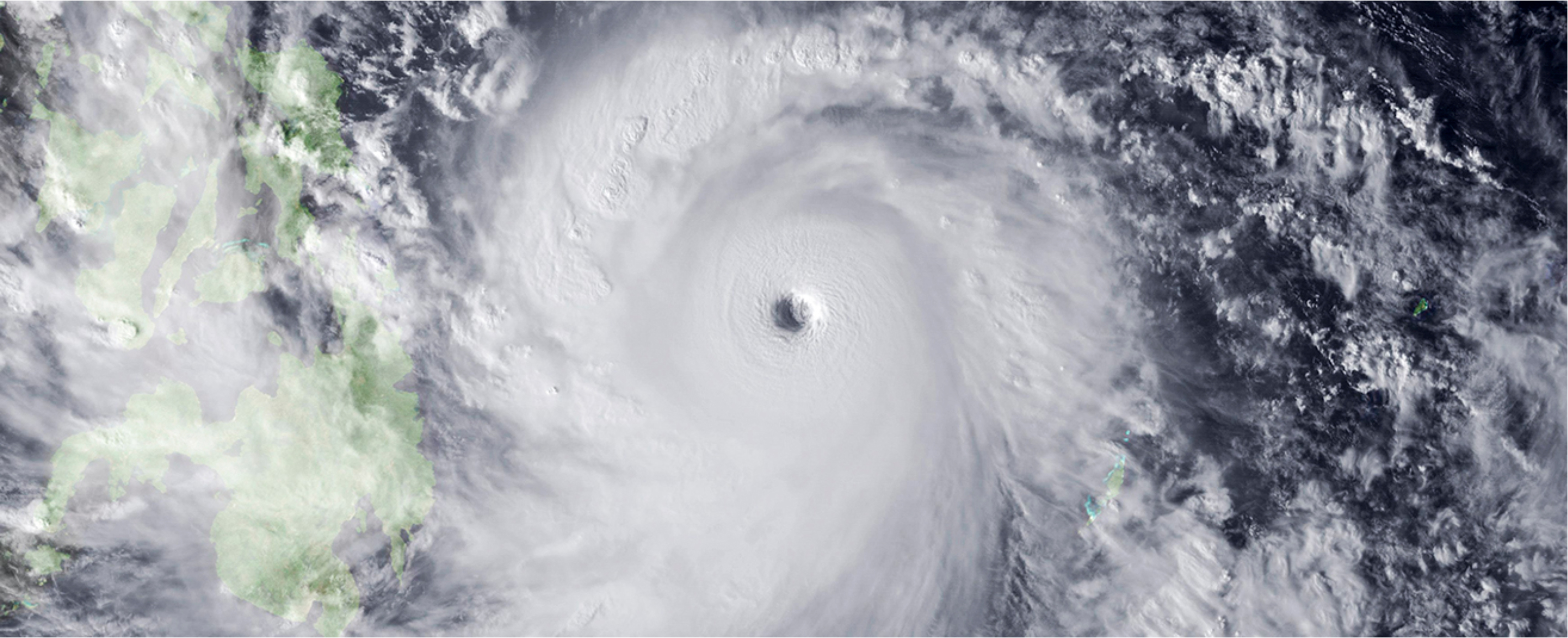 Super typhoon Haiyan in the Phillippines in November 2013. At 285 km/h, the winds were the most powerful ever recorded. More than 6,000 people died; the typhoon resulted in billions of dollars in damage. With the increasing effects of climate change extreme weather will be the new normal. Photo NASA
Super typhoon Haiyan in the Phillippines in November 2013. At 285 km/h, the winds were the most powerful ever recorded. More than 6,000 people died; the typhoon resulted in billions of dollars in damage. With the increasing effects of climate change extreme weather will be the new normal. Photo NASA
Kinder Morgan’s expansion will add 150 million tonnes of greenhouse gas emissions, annually, to this growing problem. CO2 absorbed into the ocean becomes carbonic acid, eroding shell-forming marine organisms’ ability to grow. This threatens much of the life in the sea, our ancestral home. There are no boundaries. We are this living earth.
“For future generations, stand up and speak out. To save the living treasures of this beautiful home, say NO to Kinder Morgan.
We can change how we do things: conserve more and consume less. We can call for governmental policy changes for sustainable use of alternate energy. We can help support the legal challenges of the First Nations. We can speak out in our communities and to our political representatives. But in the end, it may come down to civil disobedience, regretfully. Hopefully, it won’t reach that point but there is a possibility that it may. In that case, people have to decide what is worth more: the profits of a Texas corporation or the health and well-being of people and all our fellow living beings now and into future generations. If this project goes ahead, it is not a matter of if a disaster happens, but when.”
Film site: www.livingsalishsea.ca
Other links: www.sanjuans.org www.twnsacredtrust.ca www.georgiastrait.org www.brokepipelinewatch.ca www.raincoast.org www.realporthearings.org www.myseatosky.org
Great article.
I agree with Thomas that it’s a great article.
Great article! I appreciate how it covers from the tar sands to the Salish Sea. I was fortunate to have been able to attend the 2014 Healing Walk in the tar sands. It was a very significant event for me.
If you share Sarama’s concern about the Kinder Morgan pipeline you may be interested to know (perhaps you already do, but in my experience that would make you one of rather few people) that while the project has been approved, the route has not. The detailed route process began December 9, 2016 when the company filed sample Plan, Profile and Book of Reference (PPBoR), sample section 34 (NEB Act) notices, and a publication plan for notices with the NEB.
After several steps the final schedule of publications was filed March 3, 2017, however actual publication of notices did not match the schedule filed and in at least one instance the PPBoR was not made available as the company had committed to do.
As deadlines in the process hinge on publication dates of notices, and the PPBoR have to be available to people engaging in the process, those failures resulted in several motions being filed to extend deadlines.
The NEB gave Kinder Morgan until May 15 to respond. That response came on the 15th with a commitment to republish notices on the entire route, to file errata to PPBoR for almost the entire route, and serve new section 34(1)(a) notices to landowners of properties directly impacted by the route where those errata apply.
This effectively restarts the detailed route process under which people can file statements of opposition to the location of the pipeline route or to methods or timing of construction.
In the first round 375 statements of opposition (last I counted) had been filed from 25 communities on the route. 188 of those were from Chilliwack where the pipeline threatens the aquifer that is our drinking water source. 104 were from Burnaby. The rest were from communities all along the project with 1-9 or so statements each.
With the process restarted and new deadlines that will be 30 days from the dates of new publications and service of notices in each project segment (assuming the NEB approve the company’s plan) there will undoubtedly be more statements of opposition filed.
After the deadlines for statements the NEB will hold hearings and after those hearings will rule for each segment of the pipeline in which opposition was raised whether the proposed route is “the best possible route” for the pipeline (NEB Act section 36).
I am fairly confident that in Chilliwack the route will be rejected by the NEB. With other things in play like the June 30 deadline for confirmation of the final investment decision by Kinder Morgan in the deal between the company and the Province of B.C.–failure of which terminates that deal–and the fact that the company was unable to find a joint venture partner and has now filed to do a public share offering to try to raise the funds to begin construction on the project, it will be interesting to say the least to watch how things shake out.
Seems to me this project got as far as it did, thanks to the promotion and politicking of Stephen Harper and BC’s Christy Clark. Now we have Justin Trudeau, who has already reneged on his promise to bring in proportional representation . . . will he have the balls to stand up to BIG OIL? With BC’s recent election still hanging in the balance, demonstrating that at least half of the provinces electorate want Christy Clark OUT . . . will that be sufficient to shut down this Draconian plan to ship, via our pristine waterways, this highly toxic/environmentally disasterous crude oil??? What more can we do to convince the powers that be, that we do not want this dangerous plan to go ahead???